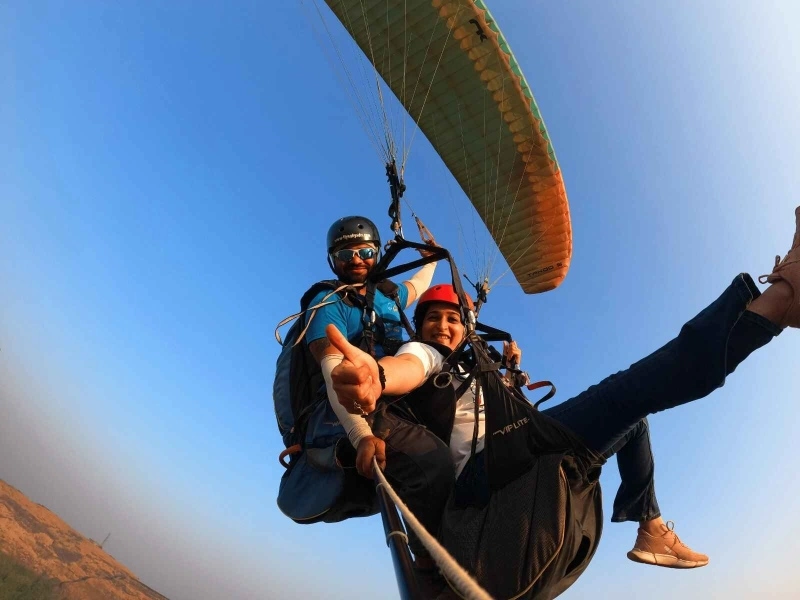Paragliding Harness Guide: Choose the Best for Safety
In order for Paragliding Lonavala enthusiasts to still enjoy the thrill of flight and at the same time reducing chances and advancing general safety levels in the sport

Paragliding at Kamshet combines several feelings such as freedom and thrill. Despite this, it is important to put in mind that one should never compromise his or her own safety whatever he or she might choose to do during spare time. This is because reserve parachutes serve as some of the essential safety devices while in action. In this feature, we will look into how important reserves and harnesses are in safety while paragliding Kamshet. It is because these elements serve as determinants that help pilots avoid accidents.
Harness and Reserves-Its Imperative Role
Paragliding safety depends to a large extent on the use of harnesses and reserves which work together in order to keep a track record of the pilots during the course of their trips in air. Pivotal roles are played together by harness and reserves in reducing risks and making paragliding more secure on the whole.
1). Harnesses- A paragliding harness connects the wing to its pilot hence making to float in the air keeping his/her safety and comfort in check. Found in many models this product is considered safe, easy and good at its duties due to many factors that have influenced its progress while maintaining a highly safe level.
2). Comfort and Support- Pilots should not have to worry about discomfort or injury while in flight, so a harness is designed to equally distribute their weight; this way, they can reduce or eliminate fatigue and strain that may occur such as during long-distance trips. It has padded shoulder straps, leg loops as well as backrests that enhance comfort and stability; hence, there will be less pressure on pilots’ bodies making them feel even more comfortable during their journey. A pilot can just concentrate on how he/she flies when having a properly fitted harness since very little risk is involved in either discomfort or physical harm of any kind.
3). Control and Maneuverability- Pilots can effectively manipulate the wing's controls by harnesses. The precise weight shifting and steering inputs are made possible by harnesses which are integrated with straps and pulleys hence enabling turns, spirals and other maneuvers. Especially in turbulent conditions, harness technique should be proper in order to maintain stability and control.
4). Protection- Harnesses design today have high safety levels for examples they are fitted with foam protection, materials that can absorb impact and strengthen structures. These components reduce injuries suffered by pilots in case they collide or make forceful landings. Other times also, the harnesses have emergency parachute packs for quick access when need be.
5). Reserves- A reserve parachute is meant to be a final option in case the canopy collapses, equipment fails, or for some other reasons. There may be times when asymmetric collapses, cravats or structural failures can require the reserve parachute to be used for safe landing although not very frequent cases.
6). Reliability and Redundancy- Reserve parachute deployment speed systems in your designed stability and firmness. They pass through strict checking up before they can be released to the public being sure that they can meet global confirmed standards for safety. Generally, an average reserve comprises one-point deployment system which enables fast opening with minimal pilot input. In tandem mode this type of reserve has an extra secondary safety net contained within its own deployment bag.
7). Deployment Mechanisms- Different deployment mechanisms are used in the case of reserve parachutes such as throw-out systems, hand-deployed systems and automatic activation devices (AADs). A pilot needs to initiate deployment by throwing the reserve parachute into the airflow. The AADs are devices that can be electronically released from a certain altitude or when the speed has reached a certain value. Another safety measure is pulling a handle or ripcord that releases the reserve from its container.
8). Training and Maintenance- It is crucial for every paragliding pilot to have adequate knowledge of how to deploy parachutes in emergency situations. Regular reserve chute checkups and repairs help in making sure that the device works properly as expected. For continued safety measures and trust in the device a pilot should always know when the manufacturer expects them to check their equipment, repack it or even buy a new one.
Final Analysis
In the fast-paced world of paragliding, safety gear is necessary for the pilot’s protection during different weather patterns. Reserves are also important and harnesses are vital in ensuring comfort, control and safety as the pilot flies confidently and with ease. In cases of emergency, reserves act as life-savers coming to one’s aid by ensuring that they land safely. In order for Paragliding Lonavala enthusiasts to still enjoy the thrill of flight and at the same time reducing chances and advancing general safety levels in the sport, it is important knowing the significance of harnesses and reserves alongside ensuring that safety practices always come first.
Fly Sahyadri Team
Paragliding Expert
An experienced paragliding instructor and pilot with over a decade of flying experience. Passionate about sharing knowledge and ensuring safe flying practices for all adventure enthusiasts.
Related Articles

Learn everything you need to know about paragliding safety and regulations. From proper equipment maintenance to understanding airspace rules

Stay safe while paragliding with these essential tips. Learn how to avoid common accidents and ensure a smooth and enjoyable flight every time.